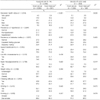1. Statistics Korea. Life tables for Korea, 1970-2015. Daejeon: Statistics Korea;2016.
2. Statistics Korea. Population projections for Korea (2015-2065)[Internet]. Daejeon: Statistics Korea;2016. cited 2018 Dec 11. Available from:
https://kosis.kr/.
3. Kim K, Hong SA, Kim MK. Nutritional status and food insufficiency of Korean population through the life-course by education level based on 2005 National Health and Nutrition Survey. Korean J Nutr. 2008; 41(7):667–681.
4. Han G, Yang E. Evaluation of dietary habit and nutritional intake of Korean elderly: data from Korea National Health and Nutrition Examination Survey 2013 ~ 2015. J East Asian Soc Diet Life. 2018; 28(4):258–271.
5. Food and Agriculture Organization of the United Nations (FAO). Food security [Internet]. Quebec: Food and Agriculture Organization;2006. cited 2018 Jun 30. Available from:
http://www.fao.org/.
6. Coleman-Jensen A, Rabbitt MP, Gregory CA, Singh A. Household food security in the United States in 2016. Washington, D.C.: United States Department of Agriculture, Economic Research Service;2017. 09. Report No.: ERR-237.
7. Lee HS. Food insecurity and related risk factors in the elderly: Korea National Health and Nutrition Examination Survey 2013 data. J Korean Diet Assoc. 2015; 21(4):308–319.

8. Kirkpatrick SI, Tarasuk V. Food insecurity is associated with nutrient inadequacies among Canadian adults and adolescents. J Nutr. 2008; 138(3):604–612.


10. Leung CW, Epel ES, Ritchie LD, Crawford PB, Laraia BA. Food insecurity is inversely associated with diet quality of lower-income adults. J Acad Nutr Diet. 2014; 114(12):1943–1953.e2.


11. Jung KH, Oh YH, Lee YK, Oh MA, Kang EN, Kim KR, et al. 2017 Investigation of elderly conditions. . Sejong: Korea Institute for Health and Social Affairs;2017. 11. Report No.: 11-1352000-000672-12.
13. Lee S, Lee KW, Oh JE, Cho MS. Nutritional and health consequences are associated with food insecurity among Korean elderly: based on the fifth (2010) Korea National Health and Nutrition Examination Survey (KNHANES V-1). J Nutr Health. 2015; 48(6):519–529.

14. Yang YJ. Socio-demographic characteristics, nutrient intakes and mental health status of older Korean adults depending on household food security: based on the 2008-2010 Korea National Health and Nutrition Examination Survey. Korean J Community Nutr. 2015; 20(1):30–40.

15. Kim HJ, Oh K. Household food insecurity and dietary intake in Korea: results from the 2012 Korea National Health and Nutrition Examination Survey. Public Health Nutr. 2015; 18(18):3317–3325.


16. Ministry of Health and Welfare, The Korean Nutrition Society. Dietary reference intakes for Koreans 2015. Sejong: Ministry of Health and Welfare;2015.
17. The Korean Nutrition Society. Dietary reference intakes for Koreans. 1st revision. Seoul: The Korean Nutrition Society;2010.
18. Ministry of Health and Welfare, Korea Centers for Disease Control and Prevention. Korea National Health and Nutrition Examination Survey raw data use guidelines, the 6th (2013-2015). Cheongju: Korea Centers for Disease Control and Prevention;2015. cited 2018 Jul 5. Available from:
knhanes.cdc.go.kr/.
19. Park GA, Kim SH, Kim SJ, Yang YJ. Health and nutritional status of Korean adults according to age and household food security: using the data from 2010 ~ 2012 Korea National Health and Nutrition Examination Survey. J Nutr Health. 2017; 50(6):603–614.
20. Nord M, Golla AM. Does SNAP decrease food insecurity? Untangling the self-selection effect. Washington, D.C.: United States Department of Agriculture, Economic Research Service;2009. 10. Report No.: EER-85.
21. Lee JS, Frongillo EA Jr. Nutritional and health consequences
are associated with food insecurity among U.S. elderly persons. J Nutr. 2001; 131(5):1503–1509.

22. Kim K, Kim MK, Shin YJ, Lee SS. Factors related to household food insecurity in the Republic of Korea. Public Health Nutr. 2011; 14(6):1080–1087.


23. Hanna KL, Collins PF. Relationship between living alone and food and nutrient intake. Nutr Rev. 2015; 73(9):594–611.


25. Baum JI, Kim IY, Wolfe RR. Protein Consumption and the Elderly: What Is the Optimal Level of Intake? Nutrients. 2016; 8(6):pii: E359.

26. Zizza CA, Duffy PA, Gerrior SA. Food insecurity is not associated with lower energy intakes. Obesity (Silver Spring). 2008; 16(8):1908–1913.


27. Choe JS, Ji SM, Park YH. The associations of household food insecurity with socioeconomic status, food behaviors, health status and nutrient intake in the elderly in rural areas. Korean J Community Living Sci. 2009; 20(1):19–32.
28. Kimura Y, Wada T, Okumiya K, Ishimoto Y, Fukutomi E, Kasahara Y, et al. Eating alone among community-dwelling Japanese elderly: association with depression and food diversity. J Nutr Health Aging. 2012; 16(8):728–731.


29. Dixon LB, Winkleby MA, Radimer KL. Dietary intakes and serum nutrients differ between adults from food-insufficient and food-sufficient families: Third National Health and Nutrition Examination Survey, 1988-1994. J Nutr. 2001; 131(4):1232–1246.


30. Vozoris NT, Tarasuk VS. Household food insufficiency is associated with poorer health. J Nutr. 2003; 133(1):120–126.


31. Tarasuk V, Mitchell A, McLaren L, McIntyre L. Chronic physical and mental health conditions among adults may increase vulnerability to household food insecurity. J Nutr. 2013; 143(11):1785–1793.


32. Park JE, An HJ, Jung SU, Lee Y, Kim CI, Jang YA. Characteristics of the dietary intake of Korean elderly by chewing ability using data from the Korea National Health and Nutrition Examination Survey 2007-2010. J Nutr Health. 2013; 46(3):285–295.








 PDF
PDF ePub
ePub Citation
Citation Print
Print







 XML Download
XML Download